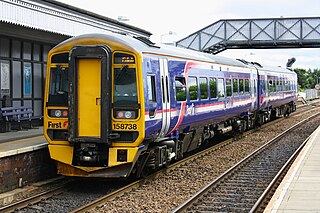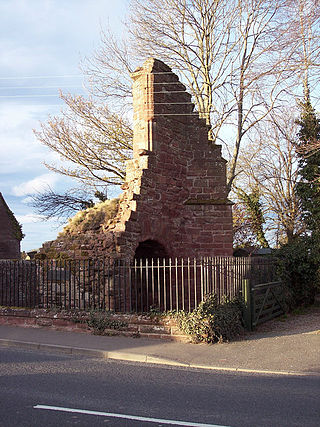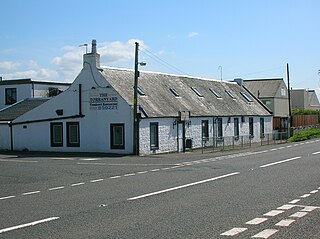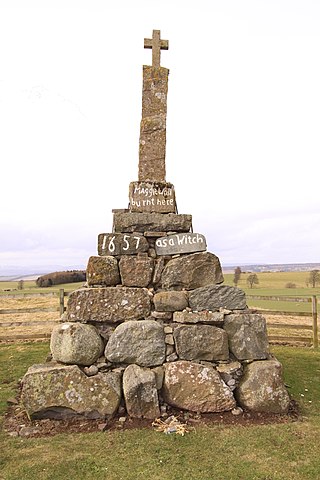
The Inner Hebrides is an archipelago off the west coast of mainland Scotland, to the south east of the Outer Hebrides. Together these two island chains form the Hebrides, which experience a mild oceanic climate. The Inner Hebrides comprise 35 inhabited islands as well as 44 uninhabited islands with an area greater than 30 hectares. Skye, Mull, and Islay are the three largest, and also have the highest populations. The main commercial activities are tourism, crofting, fishing and whisky distilling. In modern times the Inner Hebrides have formed part of two separate local government jurisdictions, one to the north and the other to the south. Together, the islands have an area of about 4,130 km2 (1,594 sq mi), and had a population of 18,948 in 2011. The population density is therefore about 4.6 inhabitants per square kilometre.

First ScotRail was a train operating company in Scotland owned by FirstGroup which operated the ScotRail franchise from October 2004 until March 2015. Prior to October 2004, trains were run by ScotRail. First ScotRail was succeeded by Abellio ScotRail on 1 April 2015.

Trotternish or Tròndairnis is the northernmost peninsula of the Isle of Skye, in Scotland. Its most northerly point, Rubha Hùinis, is the most northerly point of Skye.

The Kyle of Lochalsh line is a primarily single-track railway line in the Scottish Highlands, from Dingwall to Kyle of Lochalsh. Many of the passengers are tourists, but there are also locals visiting Inverness for shopping, and commuters. All services are provided by ScotRail and run beyond Dingwall to Inverness. In the past there were some through services to and from Glasgow, Edinburgh or Aberdeen. None of the line is electrified, and all trains on the line are diesel-powered, as are all other trains in the Scottish Highlands.
The Ghost Club is a paranormal investigation and research organization, founded in London in 1862. It is believed to be the oldest such organization in the world, though its history has not been continuous. The club still investigates mainly ghosts and hauntings.

Coupar Angus Abbey was a Cistercian monastery near Coupar Angus, in central Scotland, on the boundary between Angus and Gowrie.

Auchenharvie Castle is a ruined castle near Torranyard on the A 736 Glasgow to Irvine road. Burnhouse lies to the north and Irvine to the south. It lies in North Ayrshire, Scotland.

The Hermitage is a National Trust for Scotland-protected site in Dunkeld, Perth and Kinross. Located just to the west of the A9, it sits on the banks of the River Braan in Craigvinean Forest. It was created by John Murray, the third Duke of Atholl, who lived in nearby Dunkeld House, in the 18th century to honour the blind bard Ossian. It is home to the Georgian follies Ossian's Hall of Mirrors and Ossian's Cave. The hermit's cave was built around 1760 for the third Earl of Breadalbane, who unsuccessfully advertised for a permanent eremite. The guide in 1869, Donald Anderson, dressed up with a long beard of lichens and clothes of animal skins.
The Dingwall and Skye Railway was authorised on 5 July 1865 with the aim of providing a route to Skye and the Hebrides. However, due to local objections, another Act of Parliament was required before work could commence. This was passed on 29 May 1868.

Redgorton is a settlement in Gowrie, Perth and Kinross, Scotland. It lies a few miles from the River Tay and the A9 road, across the latter from Luncarty. It lies close to the Inveralmond Industrial Estate.

Waterloo is a small hamlet in Perth and Kinross, Scotland approximately 1⁄2 mile north of Bankfoot on the old A9.

Loch Alsh is a sea inlet between the isle of Skye in the Inner Hebrides and the Northwest Highlands of Scotland. The name is also used to describe the surrounding country and the feudal holdings around the loch. The area is rich in history, and is increasingly popular with tourists.

The Isle of Skye, or simply Skye, is the largest and northernmost of the major islands in the Inner Hebrides of Scotland. The island's peninsulas radiate from a mountainous hub dominated by the Cuillin, the rocky slopes of which provide some of the most dramatic mountain scenery in the country. Although Sgitheanach has been suggested to describe a winged shape, no definitive agreement exists as to the name's origins.
Charles McKean FRSE FRSA FRHistS FRIBA was a Scottish historian, author and scholar.

Strathpeffer railway station was a railway station serving the town of Strathpeffer in the county of Ross and Cromarty,, Scotland. The first station was located some distance from the town, on the Dingwall and Skye Railway line, and was opened in 1870.

Torranyard is a small village or hamlet in North Ayrshire, Parish of Kilwinning, Scotland. It lies between the settlements of Auchentiber and Irvine on the A736 Lochlibo Road.

Lochalsh is a district of mainland Scotland that is currently part of the Highland council area. The Lochalsh district covers all of the mainland either side of Loch Alsh - and of Loch Duich - between Loch Carron and Loch Hourn, ie. from Stromeferry in the north on Loch Carron down to Corran on Loch Hourn and as (south-)west as Kintail. It was sometimes more narrowly defined as just being the hilly peninsula that lies between Loch Carron and Loch Alsh. The main settlement is Kyle of Lochalsh, located at the entrance to Loch Alsh, opposite the village of Kyleakin on the adjacent island of Skye. A ferry used to connect the two settlements but was replaced by the Skye Bridge in 1995.
Ronald Forbes RSA, RGI is an artist who is primarily a painter but who has also made films throughout his career. He is an academician of the Royal Scottish Academy, was elected a Professional Member of the Society of Scottish Artists in 1971 and a member of the Royal Glasgow Institute of the Fine Arts in 2013.
Otta Flora MacDonald Lois Swire was a Scottish author. She published Skye: the Island and Its Legends in 1952, a collection of fireside stories she had heard from her mother and her grandmother at Orbost House, in the Isle of Skye, Scotland. Her work was drawn from and referenced by many writers, from specialists to popular authors, such as Neil Gaiman.

Maggie Wall, was believed to have been burned as a witch. She is best known for the memorial monument in Dunning, Perthshire inscribed with "Maggie Wall burnt here 1657 as a witch". The skull of Maggie Wall is claimed to be on display in the Saracen Head pub in Gallowgate, Glasgow.















